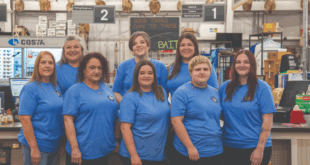Throughout 2020, home improvement retailers had to find new ways to engage their customers and boost sales. One of the key ways they achieved this connection was through digital interaction on some of the world’s biggest social media platforms. As more shoppers come to expect robust social media presences from businesses of all sizes, understanding key opportunities in each social media platform is crucial.
Investing in improving your social media outreach could be the winning tactic for small business as a new year begins. Social media marketing company HubSpot recently released its 2020 State of Marketing report, revealing surprising information on key digital opportunities for retailers. After surveying roughly 3,400 marketers from businesses of all sizes and industries, HubSpot found only 1 in 4 respondents are planning on increasing their content marketing investments. That oversight could be the perfect path for home improvement retailers to stake their claim in the digital space as a new year—and new customer expectations—arrive.
But how can you successfully market your content across platforms? On the following pages, take a tour of the world’s most popular social media platforms and get updated tips on how you can leverage their technology to advertise your business to new and returning customers.
TWITTER
Twitter can help your business engage a small but loyal audience. Though primarily meant to relay text updates to users, Twitter offers an array of options to help home improvement retailers market their business effectively.
The company suggests small business owners create content pillars, or general themes they want their account to actively explore. Common content pillars include education, inspiration and community. By establishing your own content pillars and ensuring the bulk of your tweets belong to one of those segments, you can grow your business and your audience each day.
You can fortify the content in your education pillar by sharing how-to videos from manufacturers alongside DIY advice from your own team. Take stock of the tools and projects that are selling well in your store and use that knowledge to guide your Tweets. Notice an uptick in paint and sundry sales? Embrace that trend by posting painting tips from your team and paint brands in the following days.
The inspiration content pillar is a natural fit for home improvement retailers. Share photos of DIY success stories to help customers feel motivated to tackle their own at-home projects. Retweeting messages from major home improvement stars and TV networks can help your followers see your business in a broader context.
Keeping followers updated on your community is crucial. As a small business owner, sharing important updates, business milestones and safety information for your community is one way to increase your visibility and allow your followers to instill trust in your operation.
FACEBOOK
Facebook is one of the most popular social media platforms and people across generations are active users. For this reason, it is a great resource to market your business.
Facebook differentiates itself from other social networks with its page features, which are tailored for business use, such as page moderation, address and store hour information, customizable buttons and more.
You can also promote your small business by using the Facebook Ad Center, which offers different paid advertising options, such as boosting existing posts, creating ads that will display on both Facebook and Instagram and the ability to target specific audiences through ads (you can narrow your audience by location, age, interests and more). Additionally, Facebook social media advertising can often be achieved at a lower price than traditional advertising methods.
Whether you choose to create ads or unpaid posts, showcase your products and include links that take customers to your website. Video, carousel and slideshow posts are very handy for featuring products. You can also share store events by creating posts with seasonal promotions and special events.
Facebook is a social network first, so use your page to communicate regularly and directly with customers and page visitors. Take advantage of the Messenger option to send instant replies letting customers know when they can expect a response or if they have reached you outside of normal business hours.
INSTAGRAM
Instagram is primarily a photo and video sharing social networking site. In fact, you cannot create a post without attaching a photo or video, so it is best used when you have attractive photos, videos or graphics. It is popular with users of different ages.
Instagram is owned by Facebook and includes some helpful shared features, such as the ability to post to both Facebook and Instagram at the same time or create ads for both platforms. Additionally, Instagram uses Facebook’s Messenger app for sending and receiving direct messages.
Different ways to share and create engaging content within Instagram include Stories image and video posts that expire after 24 hours, Reels for short videos often choreographed or set to music, IGTV for longer videos and paid advertising and shopping features that allow users to browse and buy products without leaving Instagram. These tools are ideal for sharing products and project ideas to inspire DIYers and customers to shop your store.
Instagram has some link limitations—you are limited to one clickable URL in your page’s bio because links included in the text of posts are not clickable. If you wish to include links with your posts, you will need to use paid Instagram advertising or use a paid outside link service such as Linkin.bio by Later, which allows you to share post links from a landing page URL in your bio. Posts that use a link service will include instructions telling users they can find a link for the post by visiting the link in the page’s bio.
YOUTUBE
YouTube is the second-most popular website on the internet. It’s a key destination for home improvement retailers who want to elevate their brand and gain new customers. While it may be tempting to think of YouTube as only a video-hosting platform, online marketing company WordStream advises small business owners to view it as a powerful search engine, behind only Google.
Presenting your business on YouTube is similar to how you do it for other platforms, but the key difference here is the power to show your business in motion, with audio and video directly from your salesfloor. Most marketers recommend keeping your videos short and snappy, usually under 3 minutes, and there are a number of outlines you can follow to construct your videos.
Lists are incredibly popular. By creating a topic such ‘What are the biggest differences between popular wood stain brands?,’ you can provide three to five responses to quickly inform and engage your audience.
How-to videos are also incredibly popular on the platform. If you or a team member are completing a DIY project, shoot some footage of the steps and compile a video summary to share with your followers. Include links to your e-commerce page for materials to help connect customers.
Behind-the-scenes videos can feed your YouTube channel. If you’re undertaking a major project, celebrating a special milestone or introducing a new team member, shoot some footage to share with your YouTube followers. This slice-of-life action offers a look at the people powering your business, helping to create a personal connection.
 Hardware Retailing The Industry's Source for Insights and Information
Hardware Retailing The Industry's Source for Insights and Information






